 Love her and leave her coming after you for revenge. 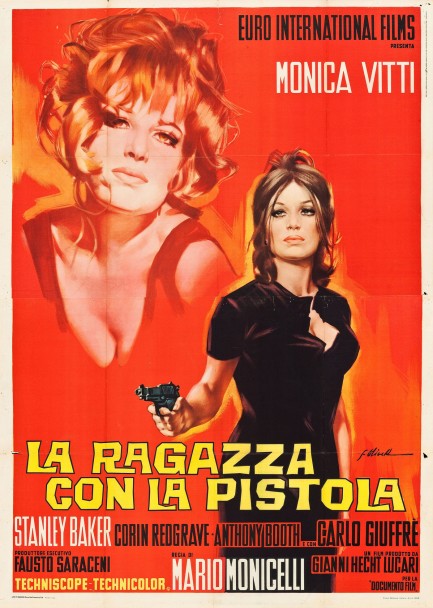
We didn't know La ragazza con la pistola, aka The Girl with a Pistol, was a comedy. Based on this beautiful poster painted by Giorgio Olivetti we never considered the possibility that it was anything other than a crime thriller. But mere seconds into our screening we realized it was a sort of screwball adventure. Sometimes you get fooled. Basically, Monica Vitti plays a Sicilian woman who is devirginized and abandoned by Carlo Giuffrè, is therefore labeled “dishonored” by her family and everyone in her village, and thus feels compelled to chase Giuffrè all the way to Edinburgh to kill him. Giuffrè manages to evade her, forcing her to follow him to Sheffield, Bath, and beyond (as she's tormented by a Sicilian chorus of wailing villagers during interstitial segments). So what you get here is a sort of wacky fish-out-of-water comedy. The movie is also a satire of traditional Italian social values. Though Vitti's character was a virgin, because she gave in to Giuffrè he automatically considers her a whore—that old paradox. Other explorations of outdated gender roles occur, including the idea of aggression versus resistance in romance. And it's eyebrow raising how men in this era—or at least in this movie—don't consider women to have possession of their own bodies. Vitti is pawed, harassed, and kidnapped—for comedic purposes, but still. The idea of using violence to retain honor pops up more than once too. All in all, La ragazza con la pistola is fascinating cultural exploration, legitimately funny in parts, headlined by one of Europe's great vintage stars. It's worth a look—even though it isn't a crime thriller. It premiered in Italy today in 1968.
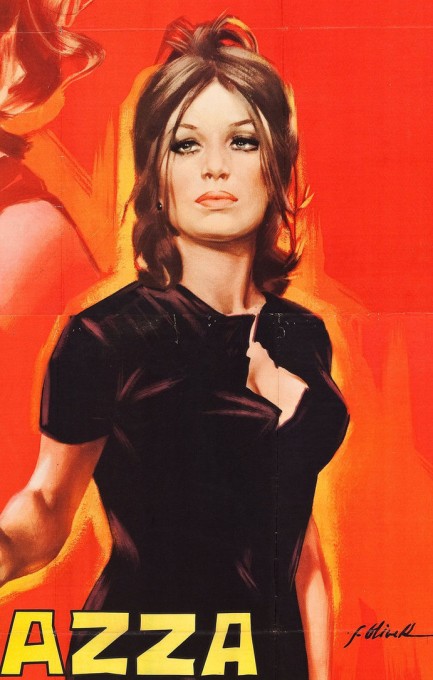 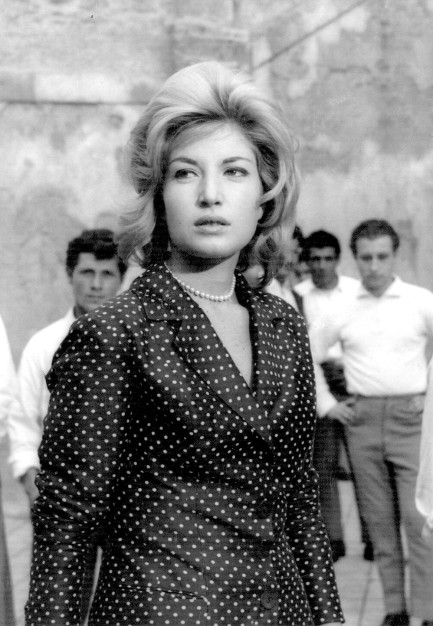 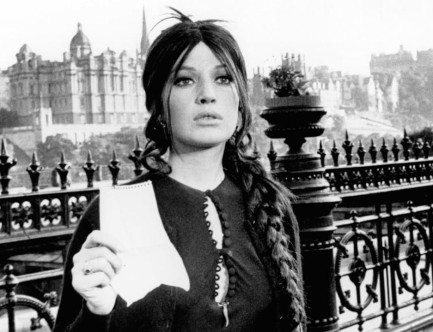 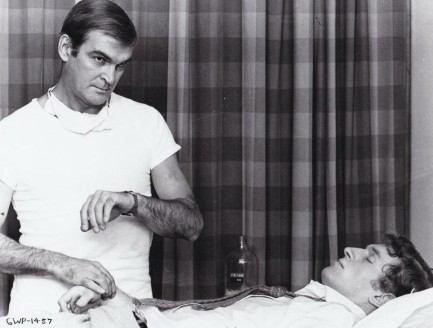 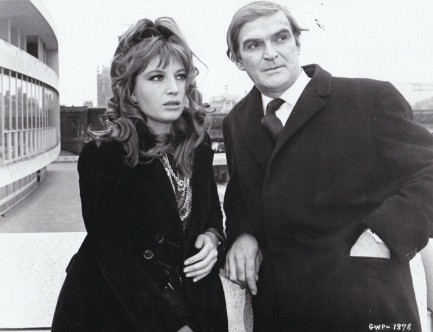 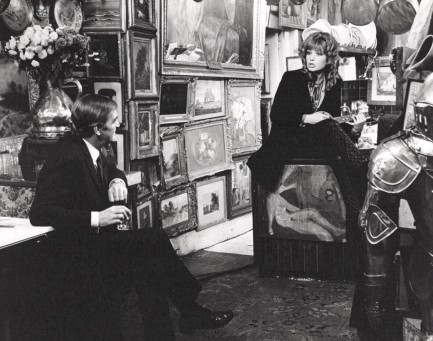 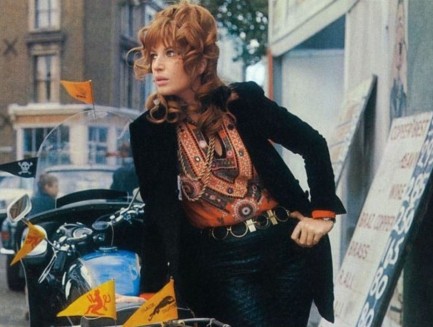 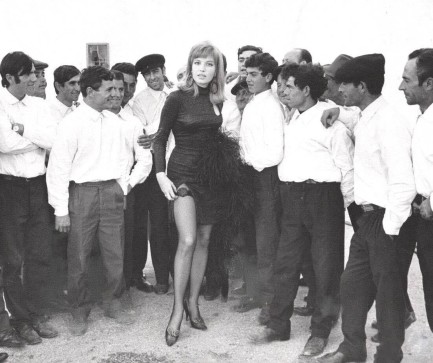
 This one might even go to 11. 
Above is a fun promo image of Scottish actress Caroline Munro, who's never far from mind because she played the unforgettable Stella Star in the 1978 sci-fi flick Starcrash. It happens to be one of our favorite films, and one of the worst ever made. It's an unbeatable combination. You can read what we wrote about it here.
 She's a one woman market disruption. 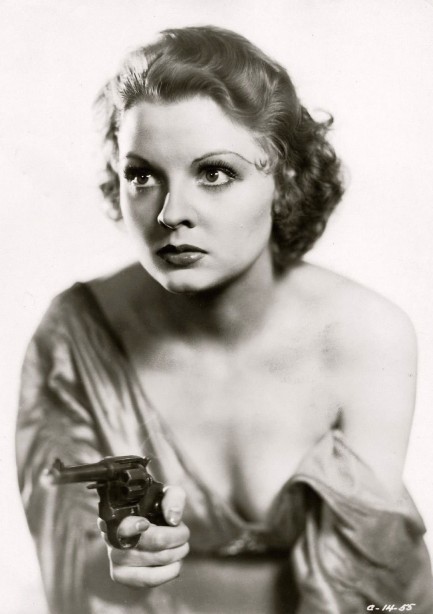
This photo shows British actress Lilian Bond, sometimes Lillian Bond, made when she was filming the 1933 romance When Strangers Marry—and when strangers marry they sometimes want to shoot each other. Other films of hers include Scotland Yard, The Picture of Dorian Gray, and The Old Dark House. We have some nice art for the latter here and here. Bond was not a big star, but she worked steadily from 1929 to 1958, which means we may run into her again.
 Murder mystery explores the turbulent years of pre-Malaysia Singapore. 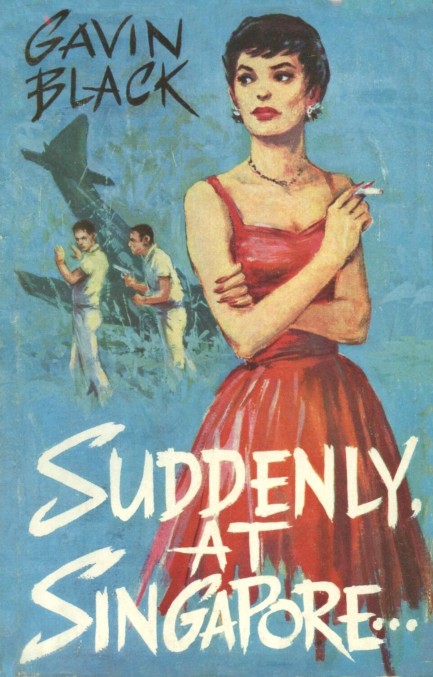
We grabbed this beautiful hardcover copy of Suddenly, at Singapore from Scottish publishers William Collins, Sons & Co. for two reasons. First, the cover art is by the legendary Barbara Walton, one of the great illustrators of the mid-century period, and the title promises exotic thrills. Though we're lucky enough to live in an exotic land ourselves, we never get tired of tales set in Asia, Africa, or the Mediterranean. And speaking of exotic, Gavin Black is a pseudonym far less exotic than the author's real name—Oswald Wynd. Why use a pen name when you're named Oswald Wynd? Beats us, though the fake name does sound more real.
Anyway, Suddenly, at Singapore involves the Harris Brothers, two adventurous anglos born and raised in Singapore who own a shipping company that, in addition to legit cargos, transports black market weapons around the Java Sea in a fleet of Chinese junks. The story opens with the older brother Jeff being murdered, and younger brother Paul vowing revenge—as soon as he figures out who ordered the killing. He's also involved in an as yet unconsummated martial affair, and is trying to send his wife back to the U.S. to get her out of his hair. The two plotlines eventually braid together, and pretty soon the hero and both his women are in all kinds of difficulties.
This was a quick read, decent not great, but with nice local color derived from Black's/Wynd's time spent in the region. The story takes place before Malaya, Singapore, North Borneo and Sarawak merged into Malaysia, and Black channels some of the political tension and economic lawlessness that prevailed during that time, but doesn't delve into it in a detailed way. He would do that later, though—we gather that this was the first of numerous Paul Harris thrillers. We also hear from those in the know that Suddenly, at Singapore is the worst of the lot, so we may try the second book Dead Man Calling when we get the hankering for South Seas craziness again.
 French publisher borrows a face for L'assassin anonyme that isn't anonyme after all. 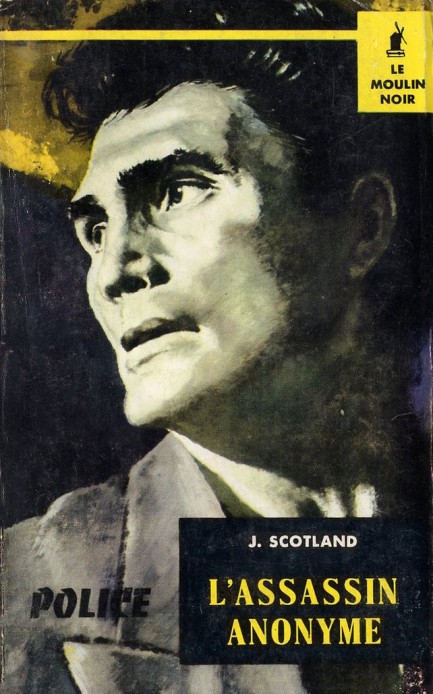
We did a double-take before reaching an inescapable conclusion—this is Jack Palance on the cover of the thriller L'assassin anonyme, published by the French group Éditions du Champ de Mars for its Collection Moulin Noir. After recognizing the face it was easy to find the photo you see below, a promo shot made for the 1950 movie Panic in the Streets. We thought the book might be a novelization of the film, but nope—it's straight up unlicensed usage of Palance's mug. The book was written by J. Scotland, which is of course a pseudonym, in this case for the prolific Viviane Cambon, who also wrote as Liane Méry, César Valentino, and—our definite favorites—Harry Mitchum and Mickey Spolane. Rumor has it she created or shared up to forty pen names. This effort is copyright 1959, and the art is uncredited.
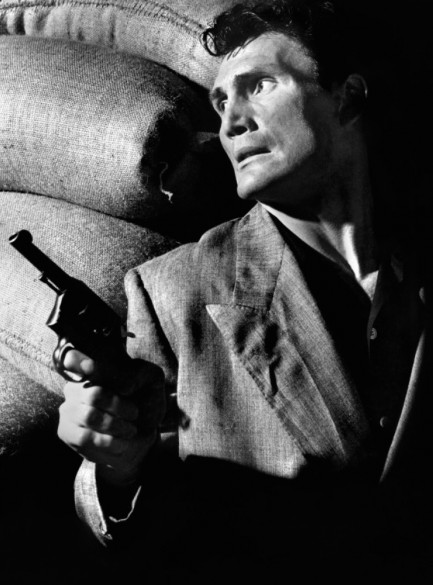
 Show me what's under yours and I'll show you what's under mine. 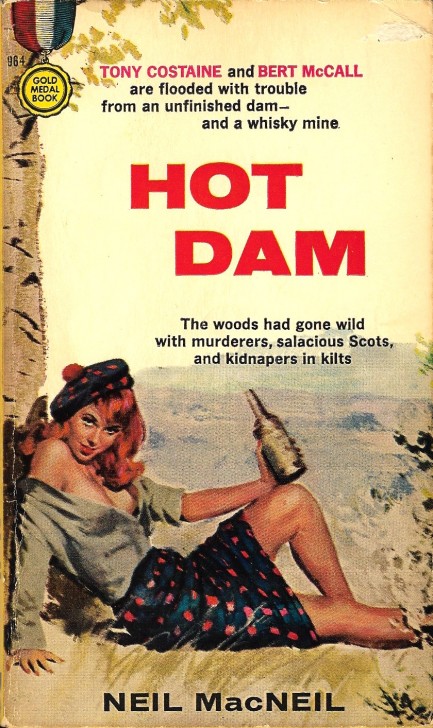
This beautiful cover for Neil McNeil's 1960 thriller Hot Dam featuring a redhead topped by a tam and wearing a kilt-like skirt is uncredited, if you can believe that. We checked around the usual spots and nobody has a clue, so into the unknown bin it goes. As for the fiction, Hot Dam is the fourth of seven novels starring McNeil's detectives Tony Costaine and Bert McCall, two toughs who don't hesitate to shoot their way into and out of trouble. This one tells the story of a valley about to be flooded after the construction of a dam, and the townspeople reluctant to move. Based on that description you'd think the good guys are the townspeople, but this is the golden age of consequence-free industry, which means it's the dam builders who are the protagonists. And of course those standing in the way of progress aren't doing it for environmental or sentimental reasons, but rather—as the cover notes—to protect a fortune in bootleg whisky hidden somewhere in the valley. The booze is owned by a clan of kilt clad Scots who have violent tendencies and a connection to old world druidism, but other villains want it too. And when McCall discovers he's related to the crazy Scots things get really interesting. Pretty good book all in all. It delivers action, an interesting setting, and both leads get laid multiple times. What more is there?
 Section of CIA trove of declassified material reveals research into psychic phenomena. 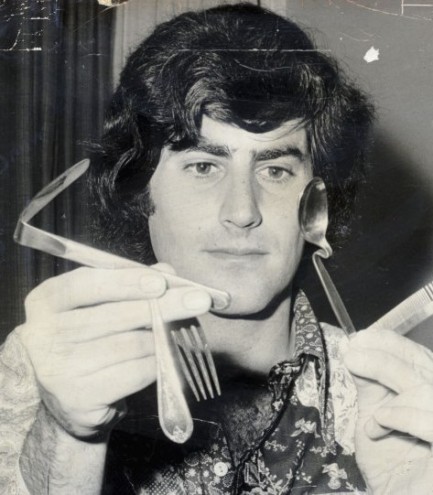
The Central Intelligence Agency has just published 800,000 formerly classified files online. The data dump, comprising some 13 million separate documents, isn't technically new. The files had been declassified years ago, but had only been available at the National Archives in Maryland, on only four computers tucked away at the back of the building which were accessible only during business hours. A freedom-of-information group called MuckRock sued the CIA and forced it to upload the collection, and the process took more than two years. Among the discoveries in the trove are documents related to the Stargate Project, which was tasked with examining psychic phenomena. A subset of those investigations involved celebrity paranormalist Uri Geller in 1973. For those who don't know, Geller is a guy who used to show up on television programs like The Tonight Show and perform various paranormal tricks. His fame drew the roving gaze of the CIA, and they had him come in for a series of tests. No word on whether he had a choice in the matter. The testers ultimately reached the conclusion that Geller was legit, stating in the declassified dox that he had, “demonstrated his paranormal perceptual ability in a convincing and unambiguous manner.” How did they reach that conclusion?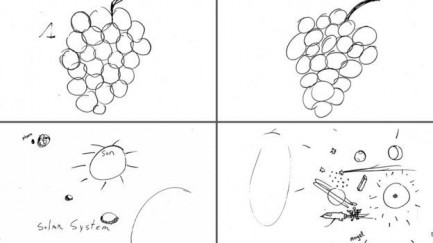 Through double blind experiments, one of which involved sealing Geller in a room, having a worker make a drawing, and asking Geller to recreate the drawing without having seen it. The images above and below show three of the original drawings, and Geller's eerily accurate renderings. Through double blind experiments, one of which involved sealing Geller in a room, having a worker make a drawing, and asking Geller to recreate the drawing without having seen it. The images above and below show three of the original drawings, and Geller's eerily accurate renderings. Geller made a nice career for himself finding hidden objects, bending spoons, and reproducing hidden sketches, but the really interesting part is he may have been a spy. In 2013, a BBC documentary titled The Secret Life of Uri Geller–Psychic Spy? claimed Geller worked for the CIA, was recruited by Mossad, and performed such missions as using only the power of his mind to erase floppy discs carried by KGB agents. Geller allegedly spent years in Mexico working as security for President José López Portillo, and the aforementioned documentary suggests he was also involved in some capacity in the famed Israeli hostage rescue in Entebbe, Uganda in 1976. It may take a few more CIA declassifications before we get to the bottom of all that. Geller is still around at age seventy (looking about fifty, which might the most convincing evidence yet of his paranormal ability) and he still appears in news reports for antics such as purchasing Lamb Island, off the eastern coast of Scotland, which was the site of many witch trials, and for building a 12 foot-tall statue of a gorilla made from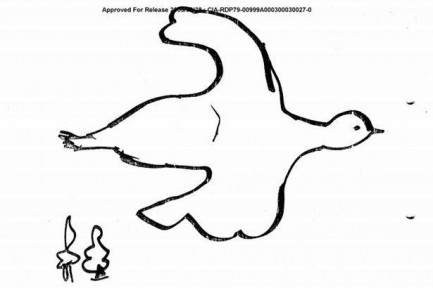 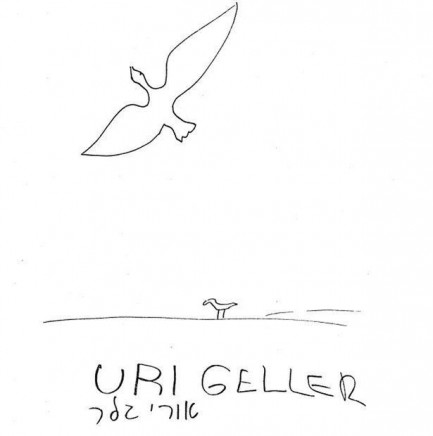 40,000 metal spoons. We aren't believers in psychic ability or any form of the paranormal. And we won't be unless we see evidence proving these realms exist. But the CIA said Geller was the real deal, so that's worth something. Of course, they also said Iraq had a nuclear weapons program, so maybe their opinion should be taken with a grain of salt. 40,000 metal spoons. We aren't believers in psychic ability or any form of the paranormal. And we won't be unless we see evidence proving these realms exist. But the CIA said Geller was the real deal, so that's worth something. Of course, they also said Iraq had a nuclear weapons program, so maybe their opinion should be taken with a grain of salt.
 Ure definitely not messing around. 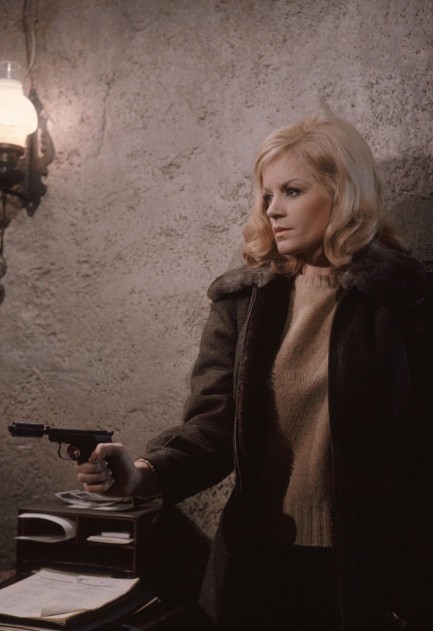
Above, a nice femme fatale style shot of Scottish actress Mary Ure, seen here brandishing a silenced pistol in an MGM promo from Where Eagles Dare, 1968. Sadly, her career was hampered by alcohol and mental illness until she fatally overdosed in 1975 aged forty-two.
 Putting the pieces back together. 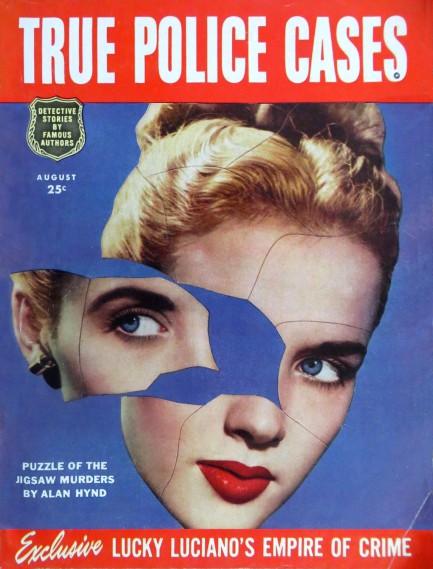
How many slayings over the years have been called “jigsaw murders”? Plenty. All a killer has to do is cut up the body and “jigsaw” becomes the go-to nickname. The particular jigsaw murders referred to on the cover of this August 1947 True Police Cases are ones committed in Lancashire, England during the late 1930s. A doctor named Buktyar Rustomji Ratanji Hakim—“Buck” for short, and aka Buck Ruxton—strangled his wife Isabella. And in a sad but classic case of wrong-place-wrong-time, a maid who had the misfortune of witnessing the event was also strangled. But Ruxton wasn’t finished. He yanked out the women’s teeth, cut off their faces, chopped up their bodies, and disposed of the pieces in a stream 100 miles from his home. The guy was really using his head. Other than needing to explain the absence of his wife and maid, he had to feel pretty confident about going undetected. But he had wrapped some of the remains in newspaper—a newspaper sold only in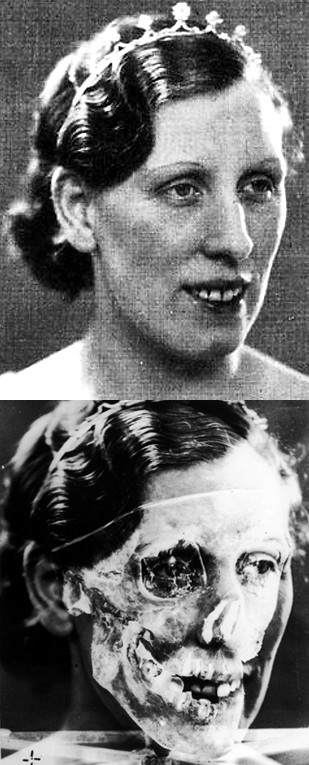 his area. That helped police zero in. And when they noted the precision of the butchery, they immediately narrowed their search to medical professionals. Needless to say, there weren’t too many doctors in the Lancashire area whose wives were suddenly missing. his area. That helped police zero in. And when they noted the precision of the butchery, they immediately narrowed their search to medical professionals. Needless to say, there weren’t too many doctors in the Lancashire area whose wives were suddenly missing. You may wonder what the trigger was for all this carnage. It was jealousy. It always seems to be jealousy. Isabella was socially quite popular, and Doc Ruxton thought she was cheating on him. He anguished over this constantly, and the couple fought often, which is the reason the poor maid didn’t realize until too late that she wasn’t witnessing just another fight. Ruxton had no actual evidence his wife was cheating, but in the end his lack of proof didn’t matter—that only meant she was too clever to be caught. Because the police used newly developed forensic techniques to help solve the crime—for instance, superimposing photos of Isabella’s face over the decomposed head to aid identification—the case generated a lot of attention. True Police Cases scribe Alan Hynd wasn’t the only journalist with an interest. Many true crime writers wrote about it, and the story eventually became an entire book by T.F. Potter in 1984 called The Deadly Dr. Ruxton: How They Caught a Lancashire Double Killer. All these years later, of the many jigsaw murderers, Buck Ruxton remains among the most famous.

|
 |

The headlines that mattered yesteryear.
2003—Hope Dies
Film legend Bob Hope dies of pneumonia two months after celebrating his 100th birthday. 1945—Churchill Given the Sack
In spite of admiring Winston Churchill as a great wartime leader, Britons elect
Clement Attlee the nation's new prime minister in a sweeping victory for the Labour Party over the Conservatives. 1952—Evita Peron Dies
Eva Duarte de Peron, aka Evita, wife of the president of the Argentine Republic, dies from cancer at age 33. Evita had brought the working classes into a position of political power never witnessed before, but was hated by the nation's powerful military class. She is lain to rest in Milan, Italy in a secret grave under a nun's name, but is eventually returned to Argentina for reburial beside her husband in 1974. 1943—Mussolini Calls It Quits
Italian dictator Benito Mussolini steps down as head of the armed forces and the government. It soon becomes clear that Il Duce did not relinquish power voluntarily, but was forced to resign after former Fascist colleagues turned against him. He is later installed by Germany as leader of the Italian Social Republic in the north of the country, but is killed by partisans in 1945.
|

|
|

It's easy. We have an uploader that makes it a snap. Use it to submit your art, text, header, and subhead. Your post can be funny, serious, or anything in between, as long as it's vintage pulp. You'll get a byline and experience the fleeting pride of free authorship. We'll edit your post for typos, but the rest is up to you. Click here to give us your best shot.

|
|

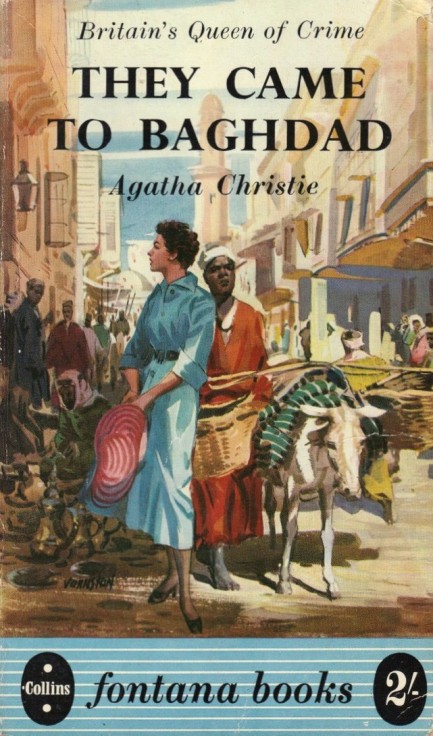


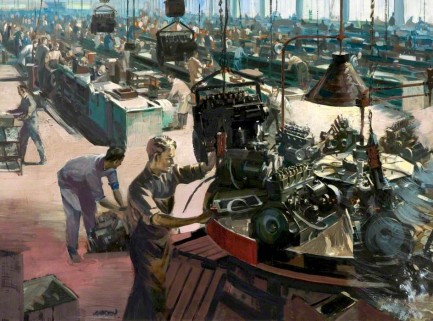
























 Through double blind experiments, one of which involved sealing Geller in a room, having a worker make a drawing, and asking Geller to recreate the drawing without having seen it. The images above and below show three of the original drawings, and Geller's eerily accurate renderings.
Through double blind experiments, one of which involved sealing Geller in a room, having a worker make a drawing, and asking Geller to recreate the drawing without having seen it. The images above and below show three of the original drawings, and Geller's eerily accurate renderings.
 40,000 metal spoons. We aren't believers in psychic ability or any form of the paranormal. And we won't be unless we see evidence proving these realms exist. But the CIA said Geller was the real deal, so that's worth something. Of course, they also said Iraq had a nuclear weapons program, so maybe their opinion should be taken with a grain of salt.
40,000 metal spoons. We aren't believers in psychic ability or any form of the paranormal. And we won't be unless we see evidence proving these realms exist. But the CIA said Geller was the real deal, so that's worth something. Of course, they also said Iraq had a nuclear weapons program, so maybe their opinion should be taken with a grain of salt.



 his area. That helped police zero in. And when they noted the precision of the butchery, they immediately narrowed their search to medical professionals. Needless to say, there weren’t too many doctors in the Lancashire area whose wives were suddenly missing.
his area. That helped police zero in. And when they noted the precision of the butchery, they immediately narrowed their search to medical professionals. Needless to say, there weren’t too many doctors in the Lancashire area whose wives were suddenly missing.




































































